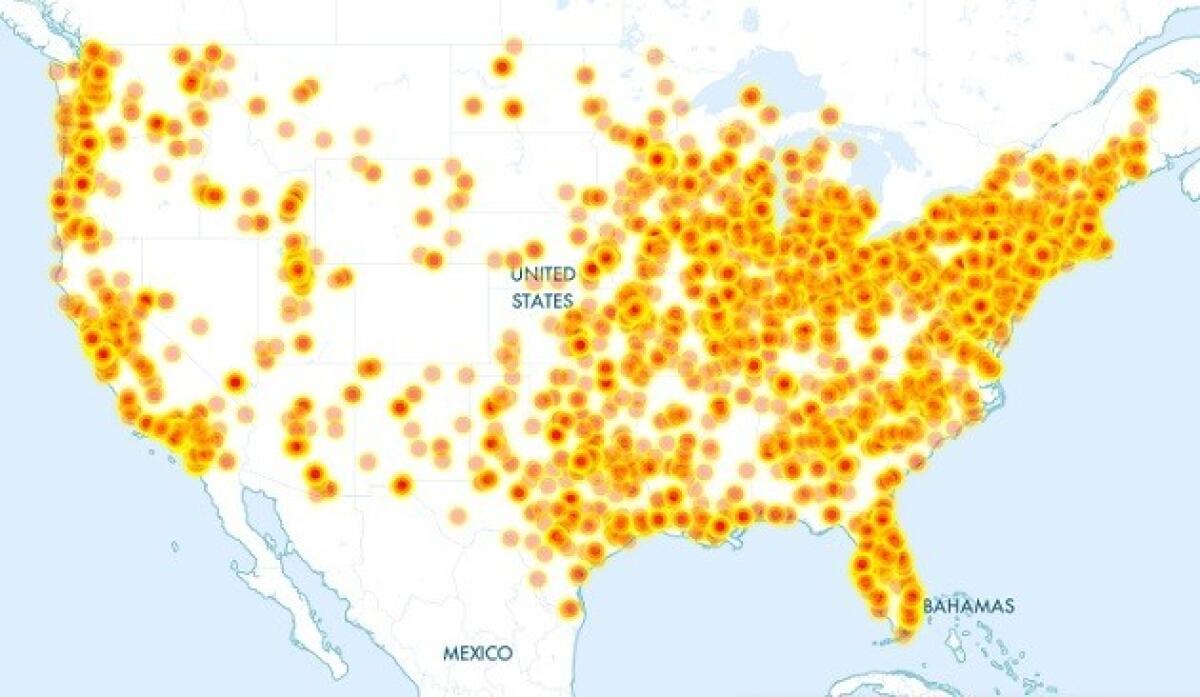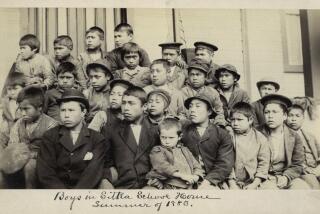In Scouting reports, a pattern of molestation

The thousands of men expelled from the Boy Scouts of America on suspicion of molesting children came from all walks of life â teachers and plumbers, doctors and bus drivers, politicians and policemen. They ranged in age from teens to senior citizens and came from troops in every state.
As the Scouts long have said, the files suggest no single profile of a predator. But a close look at nearly 1,900 confidential files opened between 1970 and 1991 revealed a pattern: Many suspected molesters engaged in what psychologists today call âgrooming behavior,â a gradual seduction in which predators lavish children with attention, favors and gifts.
In hundreds of cases, Scout leaders allowed the boys to drive cars, drink alcohol or look at pornography. They gradually tested physical boundaries during skinny dipping, group showers, sleepovers and one-on-one activities.
DATABASE: Tracking decades of allegations
âHe combs the boysâ hair and buys them clothes and dinner,â one mother wrote to a Scouting official in 1985 about an Orange scoutmaster. âHe takes them to church, motorcycle riding, skiing, flying. . . . Everybody thought he was a real nice guy. Now we know why he did these things.â
Boys in a York, Pa., troop alleged in the 1980s that their 28-year-old scoutmaster invited them for sleepovers at his house, then plied them with beer and pornography.
âAnd then as they become further inebriated and perhaps sexually excited from viewing the pornographic films, he touches them and tries to undress them, and then proceeds to do other things if he is successful,â an assistant scoutmaster noted in a memo in the file.
The confidential files, kept by the Scouts for nearly 100 years, were intended to permanently bar suspected molesters from the organization.
The Times obtained two decades of files, submitted as evidence in a court case, as well as case summaries from an additional 3,100 files opened between 1947 and 2005. Both were provided by Seattle attorney Timothy Kosnoff, who has sued the Boy Scouts more than 100 times. The dossiers â which included biographical data, legal records, Scouting correspondence, boysâ accounts of alleged abuse and media reports â represent all surviving files kept by the Scouts as of January 2005. The Scouts have destroyed an unknown number of files over the years.
Hundreds of files from the 1960s to the 1980s are set to be released Thursday by order of the Oregon Supreme Court, giving the public its first broad view of the documents.
According to the Times analysis of thousands of case summaries, at least 47% of the men expelled from the Scouts for suspected abuse were single, and at least the same portion did not have a child in the program. Those numbers could both be higher, because in many files this information was not recorded.
FULL COVERAGE: Inside the âperversion filesâ
The full case files showed that nearly all the cases arose from situations in which troop leaders were alone with boys â a practice the Boy Scouts has long discouraged and officially prohibited since 1987. At least a quarter of the cases involved contact with boys outside of official Scouting activities, at scoutmastersâ homes for instance, or on nonsanctioned camping trips.
Many of the men who were ultimately expelled from the Scouts were highly decorated troop leaders and respected members of the community. Dozens had been honored with Scouting awards such as the Silver Beaver, a distinguished service award for adult troop leaders.
John McGrew was a Dallas scoutmaster who had been recognized as teacher of the year and received a proclamation from City Hall for his work with disadvantaged youths. Two months before he was arrested on molestation charges, he was featured in Scouting Magazine, where his supervisor praised his âpersonal dedication and genuine love for these kids.â
In 1988, 16 boys testified in court that McGrew had abused them. He was convicted on several counts and sentenced to life in prison.
The grooming process and rule-breaking often ensured boysâ silence, allowing some men to serially abuse boys over a span of years before being caught. In more than 50 cases, Scout leaders were alleged to have abused 10 or more boys by the time they were expelled.
Darrald Timmie Ostopowich, an assistant scoutmaster in Los Angeles, told a psychiatrist that over four years he had sex with more than 50 boys, most of whom were Cub Scouts, according to his file. Scouting officials only learned about the abuse years later after news of his 1981 conviction was published. He is now in jail.
Scouting officials declined to be interviewed for this article. The organization released a prepared statement by Mike Johnson, the organizationâs national youth protection director, who underscored the difficulty in identifying predators before they strike.
âMy nearly 30 years of experience as a detective who investigated child sexual abuse confirms what leading youth protection professionals know: There is no profile of a potential abuser,â he said.
âThis is precisely why, in addition to using these files as a background screening tool, Scouting requires a multitiered approach to youth protection, including criminal background checks, two adult leaders at all activities and the training of all youth in personal safety awareness, including teaching them to recognize, resist and report abuse.â
Many of those reforms were adopted in the late 1980s and early 1990s, as the Scouts were named in a growing number of lawsuits and cited in reports on sexual abuse. The Times analysis found a sharp increase in the number of files opened at that time â something experts say probably reflected an increasing awareness of the problem.
Beginning in the early 1990s, some experts on the Scouts youth safety advisory panel urged the organization to study the files for patterns, but they were ignored, according to two of the experts.
âI told them I thought it would be good for someone to do a review of them for scientific purposes,â said David Finkelhor, a child abuse expert from the University of New Hampshire who served for a decade on the advisory board. âA lot of us were scientists and thought this could be very helpful. We raised it pretty regularly every year or two.â
Dr. Richard Krugman, dean of the University of Colorado Medical School and a member of the advisory board during much of the 1990s, recalled asking Scouting officials to study whether the incidence of sexual abuse changed after an abuse prevention program was adopted.
âI said it would be really nice to have the data to support everyoneâs impression that these interventions are working,â he recalled. âThe answer was no. We werenât given reasons.â
Krugman and Finkelhor said it was their impression that attorneys for the Boy Scouts decided not to do an analysis because of concerns about liability.
The result, these and other experts said, was that the Boy Scouts missed a chance to glean important insights from what is believed to be one of the largest sets of records on the alleged sexual abuse of children ever collected.
Scouting officials long have said that analyzing the files would not enhance their efforts to protect children. Last year, however, after an Oregon judge ordered about 1,200 files to be released publicly, the Scouts commissioned a study of several hundred of the files by an expert who had testified for the organization in court. University of Virginia psychiatry professor Janet Warren concluded that âthere was little information in the files concerning the techniques usedâŚto âgroomâ their alleged child victimsâ and no clear risk factors to help screen out molesters.
A clinical psychologist who also has reviewed hundreds of the files strongly disagreed, saying that the documents were full of information about the behavioral traits of âacquaintance molesters,â which were not well understood until the 1980s. Gary Schoener, who testified as an expert for the plaintiff in the Oregon case and is director of a Minneapolis mental health clinic, said an analysis of the files decades ago âwould have spurred research and we would have recognized those things much earlier.â
The Scouts missed âa chance to really understand the phenomena and construct really good education materials,â he said.
In many of the files, The Times found, patterns emerged among the alleged victims as well. The boys were often from troubled backgrounds or seeking approval from a father figure.
During an interview with prosecutors in 1990, a 17-year-old former Scout from a Valley Forge, Pa., troop haltingly described how he came to be involved in a more than yearlong relationship with 45-year-old Douglas Verney, a former policeman he met through Scouting and had come to trust âvery much.â
âI had a lot of family problems⌠And so I was kind of like emotionally ripped up and that kind of thing. I think I was looking for somebody who was there to be that comfort, you know, that parent, parental figure.â
The boy went on to describe how, over a period of months, Verney had offered him a job and began counseling him and hugging him. One day around the youthâs 16th birthday, as he was talking and crying, Verney unzipped the boyâs pants.
The relationship ended when the Scoutâs mother discovered a letter from Verney with sexual overtones. In 1990, Verney was charged with molesting him and two others, and pleaded guilty to involuntary deviate sexual intercourse, corrupting the morals of minors and sexual abuse of children.
Even as he described his sexual abuse, the boy told his interviewer that he had never intended to report it â until he heard that a 14-year-old friend had been abused as well.
âI really had no idea of cooperating at all,â he said.
DATABASE: Tracking decades of allegationsFULL COVERAGE: Inside the âperversion filesâ
Times staff researchers Maloy Moore and Daniel Schonhaut contributed to this report.
More to Read
Sign up for Essential California
The most important California stories and recommendations in your inbox every morning.
You may occasionally receive promotional content from the Los Angeles Times.











